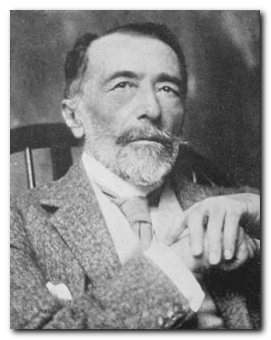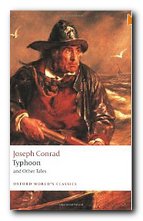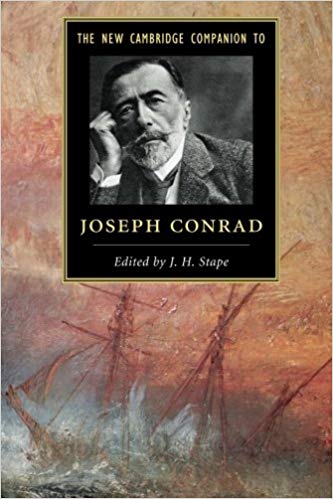tutorial, commentary, study resources, and web links
The Secret Sharer (1910) is a popular and much-anthologized work by Conrad. It’s quite short, yet it presents an enigmatic narrative and the story has been interpreted in a number of different ways. Like many of Conrad’s other stories, it combines elements of his own experience as a seaman with events recorded as part of naval history. The story is set in the Malayan Archipelago (The Gulf of Siam or Thailand to be exact) which features in a similar work, The Shadow-Line, written a few years later.

Joseph Conrad
The Secret Sharer – critical commentary
The double
There is a literary tradition of stories which deal with a theme known as ‘the double’. These are narratives featuring a character who feels the presence of, thinks he percieves, or sometimes even sees another character who has the same appearance or name as himself. The second character might succeed in society where the first character fails, or the second might perform some anti-social act for which the first character is blamed. Examples include Edgar Alan Poe’s Wiliam Wilson, Fyodor Dostoyevski’s The Double, and Vladimir Nabokov’s The Eye. For a further explanation this, see our tutorial on The Double.
Very often these stories are first person narratives in which it becomes clear to the reader that the second character does not actually exist, but is a projection of the narrator’s imagination – an ‘alternative’ personality, or ‘another self’ representing a fear or a wish-fulfilment.
The Secret Sharer is explicitly packed with the features of this theme. The unnamed narrator and Leggatt are of similar age. Both of them went to the elite sailor’s training school on the Conway. They are both bare footed when they meet. The captain gives Leggatt his own sleeping suit to wear, so that they look the same, and he puts him into his own bed. The captain immediately (and throughout the tale) refers to Leggatt as his ‘double’ and ‘secret self’. Leggatt was chief mate on the Sephora – and presumably the captain had previously been a mate before promotion to captain.
The two men echo each other’s gestures. The captain feels that they are both ‘strangers on board’. Leggatt is a stranger because he comes from another ship, the captain because he has so recently taken up his command. The captain refers to Leggatt as if he is looking in a mirror.
The story therefore seems to be variation on the double theme – and it is often discussed in such terms, particularly because none of the rest of the crew actually see Leggatt, and all information about him comes from the narrator, the captain.
This is a seductive interpretation, but it contains one major flaw. The fact is that other people in the story know that Leggatt exists. The captain of the Sephora, Archbold, comes looking for his chief mate who has escaped from the ship. So Leggatt is not a projection of the captain’s imagination, or an id to his ego. He actually exists.
There must therefore be some other means of interpreting the story, or providing an explanation for the events of the narrative.
There but for the grace of God …
Conrad often creates stories in which someone is presented with a moral dilemma or an existential crisis. This experience might also involve confronting ethically complex situations or other characters who have dared to cross the line between good and evil.
In Heart of Darkness for instance the narrator Marlowe is given the task of tracking down Kurtz, a man who has gone beyond acceptable limits in establishing his imperialist empire. Yet Marlowe, before he even meets Kurtz, is pre-disposed to admire his audacity. He asks his readers to empathise and imagine what courage it takes to break the rules of civilized society. Similar situations occur in Lord Jim and The Shadow-Line.
In The Secret Sharer we therefore have a situation where the young captain is confronted by another man of a similar age and provenance who has become embroiled in an ethically complex situation. Leggatt acts with the very best motive of saving the Sephora during a storm, and he is confronted by a weak captain and a malicious crew mate. He saves the ship, but kills his crew mate in doing so. In terms of maritime law he is guilty of a capital crime. This is an example of a good motive with a bad outcome.
But the young sea captain is entirely tolerant of Leggatt and his situation. He makes no criticism and acts instinctively to protect him from detection and capture. It’s as if he realises that he himself might have acted in a similar manner if he had been confronted by the same situation.
One can argue that the young captain acts out of class loyalty. Both he and Leggatt have come from the same training college, and the captain feels an instinct to protect his own kind. This is an interpretation which will not be popular with Conrad devotees, because it is an elitist position. And it is made even worse by the fact that at the end of the story the young captain does not appear to have learned anything.
The captain puts his own ship and the entire crew in great peril just for the sake of saving one individual from justice – something his maritime code of ethics would never condone. And yet the spirit of the narrative and Conrad’s attitude to the captain suggests a positive outcome to the story. The captain succeeds in steering clear of Koh-ring, and he feels that he has a closer relationship with the vessel he commands. This is a bad motive with a good outcome.
Interestingly, Leggatt saves the crew of the Sephora by his act of ‘setting’ a reefed foresail, but kills an individual in doing so. The young captain on the other hand does the opposite. He saves an individual (Leggatt) but puts his own crew in great danger by sailing so close to the Koh-ring island.
The Secret Sharer – study resources
![]() The Secret Sharer – Oxford World Classics – Amazon UK
The Secret Sharer – Oxford World Classics – Amazon UK
![]() The Secret Sharer – Oxford World Classics – Amazon US
The Secret Sharer – Oxford World Classics – Amazon US
![]() The Secret Sharer – Kindle eBook
The Secret Sharer – Kindle eBook
![]() The Secret Sharer – Penguin Classics – Amazon UK
The Secret Sharer – Penguin Classics – Amazon UK
![]() The Secret Sharer – Penguin Classics – Amazon US
The Secret Sharer – Penguin Classics – Amazon US
![]() The Secret Sharer – Dover Thrift – Amazon UK
The Secret Sharer – Dover Thrift – Amazon UK
![]() The Secret Sharer – Dover Thrift – Amazon US
The Secret Sharer – Dover Thrift – Amazon US
![]() The Secret Sharer – eBook versions at Project Gutenberg [FREE]
The Secret Sharer – eBook versions at Project Gutenberg [FREE]
![]() Joseph Conrad: A Biography – Amazon UK
Joseph Conrad: A Biography – Amazon UK
![]() The Cambridge Companion to Joseph Conrad – Amazon UK
The Cambridge Companion to Joseph Conrad – Amazon UK
![]() Routledge Guide to Joseph Conrad – Amazon UK
Routledge Guide to Joseph Conrad – Amazon UK
![]() Oxford Reader’s Companion to Conrad – Amazon UK
Oxford Reader’s Companion to Conrad – Amazon UK
![]() Notes on Life and Letters – Amazon UK
Notes on Life and Letters – Amazon UK
![]() Joseph Conrad – biographical notes
Joseph Conrad – biographical notes
The Secret Sharer – plot summary
Part I. A young seaman has his first command to take a sailing ship from the Gulf of Siam (Thailand) back to England. Whilst becalmed during the night at the start of the voyage he takes on board Leggatt, another senior seaman who has escaped from a nearby ship. the Sephora, after killing a malicious fellow seaman during a storm. The young captain sympathises with Leggatt’s plight and conceals him in his cabin. Leggatt gives a reasonable explanation for his actions (which saved his ship) and the young captain continues to give him refuge.
 Part II. When the captain of the Sephora comes searching for his escaped prisoner, he gives his own account of events. The crew of the young captain’s ship find his behaviour increasingly strange, but he continues to protect Leggatt. Both of them are graduates of the same training school, and the captain regards Leggatt as his ‘double’ or ‘alternative self’. After a number of number of near scrapes in being detected, Leggatt asks to be put off the ship when it nears some islands. He is willing to take his chance to make an escape. The captain takes a grave risk by sailing perilously close to an island, but in the end Leggatt slips away undetected and the captain sails on, feeling that he now has complete control of his ship.
Part II. When the captain of the Sephora comes searching for his escaped prisoner, he gives his own account of events. The crew of the young captain’s ship find his behaviour increasingly strange, but he continues to protect Leggatt. Both of them are graduates of the same training school, and the captain regards Leggatt as his ‘double’ or ‘alternative self’. After a number of number of near scrapes in being detected, Leggatt asks to be put off the ship when it nears some islands. He is willing to take his chance to make an escape. The captain takes a grave risk by sailing perilously close to an island, but in the end Leggatt slips away undetected and the captain sails on, feeling that he now has complete control of his ship.
Joseph Conrad – video biography
Principal characters
| I | the narrator, an unnamed young mariner |
| – | the chief mate with ‘terrible whiskers’ |
| – | the young second mate |
| Leggatt | the chief mate of the Sephora |
| Archbold | the captain of the Sephora |
The Secret Sharer – first book edition

First edition – J.M.Dent & Sons 1912
Critical studies
![]() Ted Billy, A Wilderness of Words: Closure and Disclosure in Conrad’s Short Fiction, Lubbock: Texas Tech University Press, 1997.
Ted Billy, A Wilderness of Words: Closure and Disclosure in Conrad’s Short Fiction, Lubbock: Texas Tech University Press, 1997.
![]() Gary Geddes, Conrad’s Later Novels, Montreal: McGill-Queen’s University Press, 1980.
Gary Geddes, Conrad’s Later Novels, Montreal: McGill-Queen’s University Press, 1980.
![]() Stephen K. Land, Conrad and the Paradox of Plot, London: Macmillan Press, 1984.
Stephen K. Land, Conrad and the Paradox of Plot, London: Macmillan Press, 1984.
![]() F.R.Leavis, ‘The Shadow-Line’, in Anna Karenina and Other Essays, London: Chatto and Windus, 1967.
F.R.Leavis, ‘The Shadow-Line’, in Anna Karenina and Other Essays, London: Chatto and Windus, 1967.

Joseph Conrad’s writing table
Further reading
![]() Amar Acheraiou Joseph Conrad and the Reader, London: Macmillan, 2009.
Amar Acheraiou Joseph Conrad and the Reader, London: Macmillan, 2009.
![]() Jacques Berthoud, Joseph Conrad: The Major Phase, Cambridge: Cambridge University Press, 1978.
Jacques Berthoud, Joseph Conrad: The Major Phase, Cambridge: Cambridge University Press, 1978.
![]() Muriel Bradbrook, Joseph Conrad: Poland’s English Genius, Cambridge: Cambridge University Press, 1941
Muriel Bradbrook, Joseph Conrad: Poland’s English Genius, Cambridge: Cambridge University Press, 1941
![]() Harold Bloom (ed), Joseph Conrad (Bloom’s Modern Critical Views, New York: Chelsea House Publishers, 2010
Harold Bloom (ed), Joseph Conrad (Bloom’s Modern Critical Views, New York: Chelsea House Publishers, 2010
![]() Hillel M. Daleski , Joseph Conrad: The Way of Dispossession, London: Faber, 1977
Hillel M. Daleski , Joseph Conrad: The Way of Dispossession, London: Faber, 1977
![]() Daphna Erdinast-Vulcan, Joseph Conrad and the Modern Temper, Oxford: Oxford University Press, 1991.
Daphna Erdinast-Vulcan, Joseph Conrad and the Modern Temper, Oxford: Oxford University Press, 1991.
![]() Aaron Fogel, Coercion to Speak: Conrad’s Poetics of Dialogue, Cambridge, Mass: Harvard University Press, 1985
Aaron Fogel, Coercion to Speak: Conrad’s Poetics of Dialogue, Cambridge, Mass: Harvard University Press, 1985
![]() John Dozier Gordon, Joseph Conrad: The Making of a Novelist, Cambridge, Mass: Harvard University Press, 1940
John Dozier Gordon, Joseph Conrad: The Making of a Novelist, Cambridge, Mass: Harvard University Press, 1940
![]() Albert J. Guerard, Conrad the Novelist, Cambridge, Mass: Harvard University Press, 1958
Albert J. Guerard, Conrad the Novelist, Cambridge, Mass: Harvard University Press, 1958
![]() Robert Hampson, Joseph Conrad: Betrayal and Identity, Basingstoke: Macmillan, 1992
Robert Hampson, Joseph Conrad: Betrayal and Identity, Basingstoke: Macmillan, 1992
![]() Jeremy Hawthorn, Joseph Conrad: Language and Fictional Self-Consciousness, London: Edward Arnold, 1979
Jeremy Hawthorn, Joseph Conrad: Language and Fictional Self-Consciousness, London: Edward Arnold, 1979
![]() Jeremy Hawthorn, Joseph Conrad: Narrative Technique and Ideological Commitment, London: Edward Arnold, 1990
Jeremy Hawthorn, Joseph Conrad: Narrative Technique and Ideological Commitment, London: Edward Arnold, 1990
![]() Jeremy Hawthorn, Sexuality and the Erotic in the Fiction of Joseph Conrad, London: Continuum, 2007.
Jeremy Hawthorn, Sexuality and the Erotic in the Fiction of Joseph Conrad, London: Continuum, 2007.
![]() Owen Knowles, The Oxford Reader’s Companion to Conrad, Oxford: Oxford University Press, 1990
Owen Knowles, The Oxford Reader’s Companion to Conrad, Oxford: Oxford University Press, 1990
![]() Jakob Lothe, Joseph Conrad: Voice, Sequence, History, Genre, Ohio State University Press, 2008
Jakob Lothe, Joseph Conrad: Voice, Sequence, History, Genre, Ohio State University Press, 2008
![]() Gustav Morf, The Polish Shades and Ghosts of Joseph Conrad, New York: Astra, 1976
Gustav Morf, The Polish Shades and Ghosts of Joseph Conrad, New York: Astra, 1976
![]() Ross Murfin, Conrad Revisited: Essays for the Eighties, Tuscaloosa, Ala: University of Alabama Press, 1985
Ross Murfin, Conrad Revisited: Essays for the Eighties, Tuscaloosa, Ala: University of Alabama Press, 1985
![]() Jeffery Myers, Joseph Conrad: A Biography, Cooper Square Publishers, 2001.
Jeffery Myers, Joseph Conrad: A Biography, Cooper Square Publishers, 2001.
![]() Zdzislaw Najder, Joseph Conrad: A Life, Camden House, 2007.
Zdzislaw Najder, Joseph Conrad: A Life, Camden House, 2007.
![]() George A. Panichas, Joseph Conrad: His Moral Vision, Mercer University Press, 2005.
George A. Panichas, Joseph Conrad: His Moral Vision, Mercer University Press, 2005.
![]() John G. Peters, The Cambridge Introduction to Joseph Conrad, Cambridge: Cambridge University Press, 2006.
John G. Peters, The Cambridge Introduction to Joseph Conrad, Cambridge: Cambridge University Press, 2006.
![]() James Phelan, Joseph Conrad: Voice, Sequence, History, Genre, Ohio State University Press, 2008.
James Phelan, Joseph Conrad: Voice, Sequence, History, Genre, Ohio State University Press, 2008.
![]() Edward Said, Joseph Conrad and the Fiction of Autobiography, Cambridge Mass: Harvard University Press, 1966
Edward Said, Joseph Conrad and the Fiction of Autobiography, Cambridge Mass: Harvard University Press, 1966
![]() Allan H. Simmons, Joseph Conrad: (Critical Issues), London: Macmillan, 2006.
Allan H. Simmons, Joseph Conrad: (Critical Issues), London: Macmillan, 2006.
![]() J.H. Stape, The Cambridge Companion to Joseph Conrad, Cambridge: Cambridge University Press, 1996
J.H. Stape, The Cambridge Companion to Joseph Conrad, Cambridge: Cambridge University Press, 1996
![]() John Stape, The Several Lives of Joseph Conrad, Arrow Books, 2008.
John Stape, The Several Lives of Joseph Conrad, Arrow Books, 2008.
![]() Peter Villiers, Joseph Conrad: Master Mariner, Seafarer Books, 2006.
Peter Villiers, Joseph Conrad: Master Mariner, Seafarer Books, 2006.
![]() Ian Watt, Conrad in the Nineteenth Century, London: Chatto and Windus, 1980
Ian Watt, Conrad in the Nineteenth Century, London: Chatto and Windus, 1980
![]() Cedric Watts, Joseph Conrad: (Writers and their Work), London: Northcote House, 1994.
Cedric Watts, Joseph Conrad: (Writers and their Work), London: Northcote House, 1994.
Other novels by Joseph Conrad
 Lord Jim (1900) is the earliest of Conrad’s big and serious novels, and it explores one of his favourite subjects – cowardice and moral redemption. Jim is a ship’s captain who in youthful ignorance commits the worst offence – abandoning his ship. He spends the remainder of his adult life in shameful obscurity in the South Seas, trying to re-build his confidence and his character. What makes the novel fascinating is not only the tragic but redemptive outcome, but the manner in which it is told. The narrator Marlowe recounts the events in a time scheme which shifts between past and present in an amazingly complex manner. This is one of the features which makes Conrad (born in the nineteenth century) considered one of the fathers of twentieth century modernism.
Lord Jim (1900) is the earliest of Conrad’s big and serious novels, and it explores one of his favourite subjects – cowardice and moral redemption. Jim is a ship’s captain who in youthful ignorance commits the worst offence – abandoning his ship. He spends the remainder of his adult life in shameful obscurity in the South Seas, trying to re-build his confidence and his character. What makes the novel fascinating is not only the tragic but redemptive outcome, but the manner in which it is told. The narrator Marlowe recounts the events in a time scheme which shifts between past and present in an amazingly complex manner. This is one of the features which makes Conrad (born in the nineteenth century) considered one of the fathers of twentieth century modernism.
![]() Buy the book from Amazon UK
Buy the book from Amazon UK
![]() Buy the book from Amazon US
Buy the book from Amazon US
 Heart of Darkness (1902) is a tightly controlled novella which has assumed classic status as an account of the process of Imperialism. It documents the search for a mysterious Kurtz, who has ‘gone too far’ in his exploitation of Africans in the ivory trade. The reader is plunged deeper and deeper into the ‘horrors’ of what happened when Europeans invaded the continent. This might well go down in literary history as Conrad’s finest and most insightful achievement, and it is based on his own experiences as a sea captain. This volume also contains ‘An Outpost of Progress’ – the magnificent study in shabby cowardice which prefigures ‘Heart of Darkness’.
Heart of Darkness (1902) is a tightly controlled novella which has assumed classic status as an account of the process of Imperialism. It documents the search for a mysterious Kurtz, who has ‘gone too far’ in his exploitation of Africans in the ivory trade. The reader is plunged deeper and deeper into the ‘horrors’ of what happened when Europeans invaded the continent. This might well go down in literary history as Conrad’s finest and most insightful achievement, and it is based on his own experiences as a sea captain. This volume also contains ‘An Outpost of Progress’ – the magnificent study in shabby cowardice which prefigures ‘Heart of Darkness’.
![]() Buy the book from Amazon UK
Buy the book from Amazon UK
![]() Buy the book from Amazon US
Buy the book from Amazon US
© Roy Johnson 2012
Joseph Conrad web links
![]() Joseph Conrad at Mantex
Joseph Conrad at Mantex
Biography, tutorials, book reviews, study guides, videos, web links.
![]() Joseph Conrad – his greatest novels and novellas
Joseph Conrad – his greatest novels and novellas
Brief notes introducing his major works in recommended editions.
![]() Joseph Conrad at Project Gutenberg
Joseph Conrad at Project Gutenberg
A major collection of free eTexts in a variety of formats.
![]() Joseph Conrad at Wikipedia
Joseph Conrad at Wikipedia
Biography, major works, literary career, style, politics, and further reading.
![]() Joseph Conrad at the Internet Movie Database
Joseph Conrad at the Internet Movie Database
Adaptations for the cinema and television – in various languages. Full details of directors and actors, production notes, box office, trivia, and quizzes.
![]() Works by Joseph Conrad
Works by Joseph Conrad
Large online database of free HTML texts, digital scans, and eText versions of novels, stories, and occasional writings.
![]() The Joseph Conrad Society (UK)
The Joseph Conrad Society (UK)
Conradian journal, reviews. and scholarly resources.
![]() The Joseph Conrad Society of America
The Joseph Conrad Society of America
American-based – recent publications, journal, awards, conferences.
![]() Hyper-Concordance of Conrad’s works
Hyper-Concordance of Conrad’s works
Locate a word or phrase – in the context of the novel or story.
More on Joseph Conrad
Twentieth century literature
More on Joseph Conrad tales
